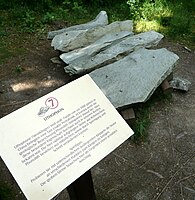Lithophone


A lithophone is a musical instrument consisting of a rock or pieces of rock which are struck to produce musical notes.[1] Notes may be sounded in combination (producing harmony) or in succession (melody). It is an idiophone comparable to instruments such as the glockenspiel, vibraphone, xylophone and marimba.
In the
Notable examples
A rudimentary form of lithophone is the "
The Txalaparta (or Chalaparta), a traditional Basque instrument, can be made of wood or stone, but is traditionally wood.
More sophisticated lithophones utilize trimmed and individually mounted stones to achieve full-scale instruments:
- Probable prehistoric lithophone stones have been found at Sankarjang in Odisha, India.[3]
- Recent research into usage wear and acoustics of prehistoric stone artefacts in North America and Europe has revealed a number of possible portable lithophones.[4][5]
- Vietnamese lithophones dating back to ancient times, called đàn đá, have been discovered and revived in the 20th century.
- The ritual music of Korea features the use of stone chimes called pyeongyeong, derived from the Chinese bianqing.
- The Keswick Museum and Art Gallery.
- A lithophone called the Musical Stones has been created at Brantwood, the former home of John Ruskin in Cumbria, England, and may be played there by visitors.[6]
- The Silex Piano, circa 1885, employed suspended flints of various sizes which were struck with other flints to produce sounds.
- Composer-vibraphonist Wolfgang Lackerschmid uses an instrument called the gramorimba, which is featured alongside the vibraphone and marimba in a trio setting.
- Icelandic post-rock band Sigur Rós played a slate marimba, which sculptor Páll Guðmundsson constructed from rocks found in Iceland.[7] This is demonstrated in their DVD Heima.[8]
- The stone marimba.
- The hōkyō, a lithophone invented in Japan, has been made from the bars of sanukite.[9]
- The German composer Carl Orff calls for a lithophone called Steinspiel in his later works.[citation needed]
- Some lithophones include electric pickups to amplify the sounds.[citation needed]
As architectural elements
Ancient Indians were perhaps the first to use man-made lithophones as architectural elements. Temples like Nellaiyappar temple (8th century) in Tirunelveli, Vijaya Vitthala temple (15th century) in Hampi, Madurai Meenakshi temple (16th century) and Suchindram Thanumalayan temple (17th century) have musical pillars.[10]
Stone marimba
A stone marimba is configured in the same manner as the more typical wooden bar
In 1949 an ancient stone marimba was discovered in modern-day Vietnam near a village called Ndut Lieng Krak. The 11 stone plates, made of schist, were chipped into the tuning of a pentatonic scale. They are currently housed at the Musée de l'Homme and may be the oldest known musical instrument.[11]
-
Lithophone made of Phonolite in the Schellerhau botanic garden (Germany)
-
Ethiopian Lithophones with Stand, Monastery of Na’akuto La’ab
-
Stone marimba, range C3–C5
-
Stone xylophone, Clore Garden of Science, Weizmann Institute of Science, Rehovot, Israel
-
Stone chimes, Shandong Provincial Museum, Jinan
See also
References
- OCLC 223164947.
- ^ "Ancient land where stones can sing". CNN. 12 December 2018. Retrieved 19 June 2024.
- ^
P. Yule/M. Bemmann, Klangsteine aus Orissa Die frühesten Musikinstrumente Indiens?, Archaeologia Musicalis 2.1, 1988, 41–50 (also in English and French); Paul Yule, Rätsel indischer Kultur, in: H.-G. Niemeyer - R. Pörtner (eds.), Die großen Abenteuer der Archäologie (Salzburg 1987) vol. 10, p. 3739 ISBN 385012150X.
- .
- ^ "Flint Tools as Portable Sound-Producing Objects in the Upper Palaeolithic Context: An Experimental Study". Archived from the original on 17 April 2021. Retrieved 28 March 2021.
- ^ "Musical Stones: Rock music from the Cumbrian Hills". Brantwood Trust. Archived from the original on 28 January 2013. Retrieved 6 January 2013.
- ^ "Pįll Gušmundsson - Żmis verkefni". Archived from the original on 7 April 2018. Retrieved 23 November 2018.
- ^ "Sigur Rós - Surtshellir (stone marimba) - Heima". YouTube. Archived from the original on 13 December 2021. Retrieved 19 April 2021.
- ^ "Science Links Japan | A new percussion instrument "hokyo" made of Sanukite". Archived from the original on 16 July 2011. Retrieved 6 October 2015.
- ^ Prasad, M.G.; Rajavel, B. "Musical pillars and singing rocks" (PDF). Taranga. Retrieved 28 January 2018.
- ^ The stones of Ndut Lieng Krak. New Scientist. 10 January 1957. p. 8.
External links
- The British composer Will Menter Will Menter, sculptures sonores, sound sculptures, musique contemporaine invented the llechiphone, a marimba with keys made of slate, while working in North Wales.Will Menter lithophones and mbiras
- UK Musician, Tony Dale developed a resonated slate lithophone in 1984 featured by composer John Hardy.
- Other slate lithophones, called stonaphones, are made in the U.S. state of
- An installation in Quark Park by Perry Cook and Jonathan Shor, consisting of 17 bars stretched over a 35-foot (11 m) long path.
- Audio and video of Stalacpipe Organ on Sound Tourism site
- lithophones.com Photographs, audio clips, and videos of lithophones from around the world, historical and contemporary.





